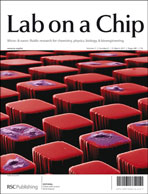In conventional DNA microarray hybridization, delivery of target cDNAs to surface-bounded probes depends solely on diffusion, which is notoriously slow, and thus typically requires 6–20 h to complete. In this study, piezoelectric microagitation through a liquid coupling medium is employed to enhance DNA hybridization efficiency and the results are compared with the standard static hybridization method. DNA hybridization was performed in a sealed aluminium chamber containing DNA microarray glass chip, coupling medium and piezoelectric transducers. 3 × SSC (Saline Sodium Citrate) was used as a coupling medium to prevent overheating of the piezoelectric transducers and to effectively transmit ultrasonic wave to the glass chip. Flow visualization using fluidic dye and velocimetry (PTV) technique was applied to observe fluid transport in the hybridization chamber. It was revealed that the dye solution was homogeneously distributed within 10 min under dynamic agitation while it took over 1 h to reach the same level of homogeneity in static condition. Plasmodium falciparumDNA microarrays and total RNA extracted from parasite cells were used as a model for DNA microarray experiments. It was found that the required hybridization time may be substantially reduced from 16 h to 4 h by the use of dynamic hybridization scheme. With the same hybridization time of 16 h, dynamic hybridization resulted in higher fluorescent signals of ∼33% and ∼24% compared to static hybridization in Cy3 and Cy5 channels, respectively. Additionally, good/effective spots, some of which were not formed by static method, were enhanced and distributed more uniformly over the microarray. Therefore, the developed dynamic hybridization with integrated piezoelectric microagitation platform is highly promising for DNA analysis in molecular biology and medical applications.

You have access to this article
 Please wait while we load your content...
Something went wrong. Try again?
Please wait while we load your content...
Something went wrong. Try again?


 Please wait while we load your content...
Please wait while we load your content...